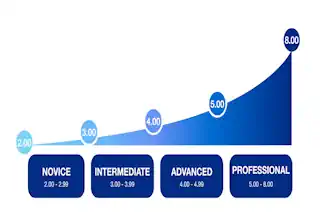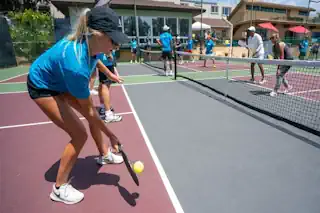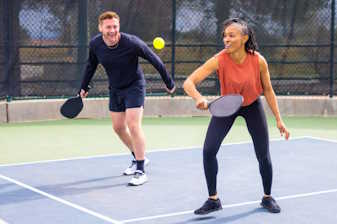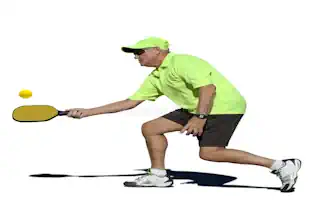Pickleball Tournament Rules: The Comprehensive Playbook for Winning

Paddle in hand, sweat on your brow, and the thrill of competition electrifying the air; this is what pickleball players live for, especially for those ready to take on the challenge of tournament play. If you’re a pickleball enthusiast or a recreational player considering the leap into competitive waters, understanding tournament rules is the linchpin of your success. This sport, which combines the dynamism of tennis, the precision of table tennis, and the strategy of badminton, has captivated players of all ages. But to truly master it, you must first understand the framework in which competitive play is governed. This in-depth exploration will guide you through the specifics of pickleball tournament rules, providing you with the tools you need to play like a pro.
Understanding the Courtside Chess Match
We have already covered the basic rules, it’s crucial to appreciate the fabric of competition in pickleball, which often resembles a chess match in its strategic maneuvering. Whether you’re playing Singles or Doubles team, each maneuver carries weight, and understanding the official rules is key to outsmarting your opponents. In this section, we’ll first digest the different types of tournaments, from casual round-robin settings to the high stakes of bracket-style competitions. Then, we’ll break down the rules specific to each match type, including scoring systems and court regulations.
Types of Pickleball Tournaments to Tantalize Players
Tournaments come in various flavors, ranging from skill-level-based competitions like the USAPA Nationals to casual, local club events. But no matter the setting, they share a common goal of pitting players against varied competition, pushing their limits and fostering a spirit of sportsmanship. Each tournament format adds a layer of complexity or challenge, such as the power struggle for the Golden Medal in a Double Round Robin or the mental endurance required for a Single Elimination Bracket.

Here are the top 5 types of tournament formats that every pickleball aficionado should look forward to:
Round Robin: A friendly yet competitive format where every player or team gets to play against every other participant. It’s perfect for those who enjoy plenty of playtime and want to experience a breadth of competition.
Single Elimination Bracket: The stakes are high in this cutthroat format; lose once, and you’re out. This is ideal for players who thrive under pressure and enjoy the thrill of do-or-die matches.
Double Elimination Bracket: Offering a second chance, this format allows players to lose once and still have a shot at the championship, making it great for those who love the competition but appreciate a safety net.
Skill-level Based: Specifically designed tournaments like the USAPA Nationals where players compete against others of similar skill levels, ensuring fair and challenging play for all involved.
Ladder: A unique format where players move up or down the ladder based on their performance in each match, perfect for those who enjoy continuous competition and the opportunity to steadily climb the ranks.
Tournament Rules Breakdown
In pickleball, the rules between singles and doubles aren’t worlds apart, but the nuances are worth noting. For example, serving on doubles team requires a specific pattern to prevent confusion and ensure fairness. Meanwhile, the court itself becomes a strategic tool, with its ‘kitchen’ or non-volley zone challenging players to defend smartly and tread carefully to avoid foot faults.
The Nuts and Bolts of Competition
With a firm understanding of pickleball tournament types under our belts, it’s time to lace up our sneakers and examine the key rules and regulations that can make or break a match. Serving, faults, and the dreaded non-volley zone are all elements that heavily influence the game. Let’s serve up an explanation.
The Art of the Serve
Serving is the first shot that can set the tone of a match. For it to be legal, it must cross the net and land in the diagonally opposite service court. But it’s not just about placement; the correct motion and location are vital.
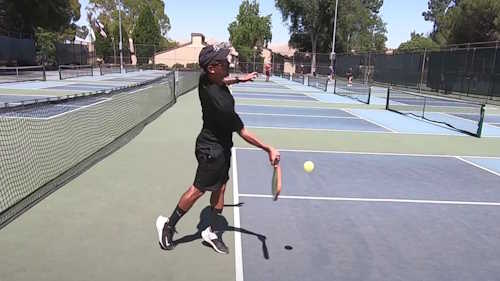
Top Ten Pickleball Serving Rules You Need to Know
Serve from Behind the Baseline: Ensure you’re behind the baseline when serving. Stepping over before making contact is a fault.
Diagonal Service: The serve must land in the diagonally opposite service court. If it lands outside, it’s a fault.
Below Waist Service: The paddle must hit the ball at or below the waist level. This keeps the serve from becoming too aggressive.
Paddle Below Wrist: When serving, the paddle head must be below your wrist, ensuring an underhand motion.
No Bouncing: The ball must be served in the air without bouncing it on the court first.
Serve in One Attempt: You get only one attempt to make your serve right, except in the event of a “let” (the ball touches the net on serve and still lands in the right service box).
Keep Feet Behind the Line: Both feet must remain behind the baseline until after you have struck the ball.
Double Bounce Rule: After the serve, the ball must bounce once on the opponent’s side before it can be returned, and then bounce once on the serving team’s side before being returned. This rule applies to the first two interactions with the ball.
No Volley Zone on Serve: The served ball cannot land in the non-volley zone (the kitchen). If it does, it’s considered a fault.
Serving Sequence in Doubles: In doubles play, teams serve in an alternating pattern until a fault is made, then the service passes to the other team. Each team member must serve before service switches to the opponent team, except at the beginning of a new game where only one player serves before switching.
Faults and Lets – When to Play On
Mistakes happen, and in pickleball, certain actions result in a point for the opposing team. From serving into the wrong court to touching the net as you play, this section will cover the most common faults and the etiquette of “lets,” those moments where a player might call a do-over.
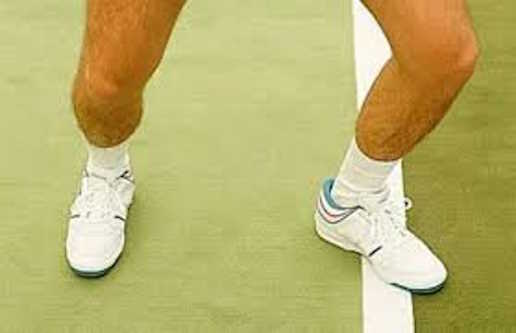
Top 5 Common Faults and Lets in Pickleball
Foot Faults: This occurs when a player steps into the non-volley zone (the kitchen) or on its line during a volley. It’s a critical aspect to watch for, as respecting the kitchen lines plays a pivotal role in strategic play.
Service Faults: A service fault can happen if the ball is served out of bounds, does not clear the net, lands in the non-volley zone, or if the player serving steps on or past the baseline before hitting the serve. Remember, precision and adherence to serving rules are key.
Double Hits: Though rare, double hits happen when a player strikes the ball twice in succession, which is against the rules. It’s all about that clean, singular contact with the ball.
Non-Volley Zone Violations: Any volley played while stepping on or inside the non-volley zone line is a fault. The allure of the kitchen can be tempting, but players must exhibit control and patience.
Lets for Service: Unlike faults, a “let” on serve occurs when the ball hits the net but still lands in the appropriate service box. In this case, the serve is typically redone without penalty, offering a second chance at getting the perfect serve in.
Navigating the Non-Volley Zone
In pickleball, the non-volley zone, also known as the ‘kitchen’, is a no-bounce zone that requires finesse to negotiate. Players cannot volley, or hit the ball without it bouncing, while fully inside the zone, adding a strategic challenge to close-range exchanges. This section will unravel the non-volley zone regulations to help you skirt your way to victory without falling foul.
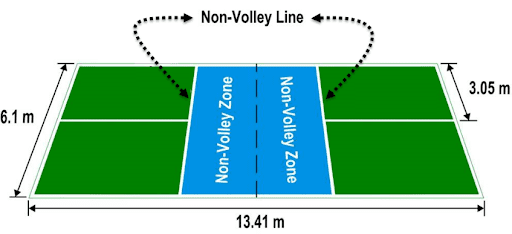
Top 5 Rules for Navigating the Non-Volley Zone
Always Keep Your Feet Out: Ensure that none of your feet or any part of your body touches the non-volley zone or its line during a volley. The precision of staying just behind it can be the difference between a point won or lost.
Bounce First Inside the Kitchen: If you’re planning to strike the ball while standing in the non-volley zone, remember the ball must first bounce. This rule encourages strategic play and positioning.
No Volleying on the Fly: Volleying the ball (hitting it without a bounce) from inside the non-volley zone is strictly prohibited. It’s all about patience and picking the right moment to step forward.
The Two-Bounce Rule Applies: After the serve, remember the two-bounce rule which requires the ball to bounce once on each side of the court before players can start volleying. This applies to serves and returns and calls for a strategic mind to manage the constrains of the non-volley zone effectively.
Avoid Momentum Faults: Be careful of momentum carrying you into the non-volley zone after a shot. Even if the ball is dead, entering the kitchen due to momentum from your swing counts as a fault.
Unlocking Strategies for a Grand Slam
Digging deeper, we will explore the strategic implications of knowing and playing within the tournament rules. From exploiting your opponent’s errors to the subtle tactics of playing the percentages, competitive pickleball requires a strategic mindset as much as it does physicality.
The Importance of Regulation Recognition
Understanding the rules goes beyond avoiding penalties; it can be a pathway to outmaneuvering your opponent.
Top 5 Advantages of Regulation Recognition in Pickleball
Anticipation and Preparation: Knowing the rules inside and out allows you to anticipate your opponent’s moves and prepare your responses more effectively. This knowledge gives you a strategic edge, allowing for quicker decision-making. Don’t let the point differential of the serving team’s score change your outlook in upcoming matches. Trust your preparation and enjoy each match.
Creating Opportunities: By understanding the boundaries set by the regulations, you can create opportunities for yourself. This might mean forcing your opponent into a difficult position or taking advantage of the rules to secure a point.
Minimizing Faults: A clear understanding of the rules helps minimize the number of faults you commit, keeping the game in your favor and reducing unnecessary point losses.
Enhancing Sportsmanship: A deep respect and knowledge of the rules contribute to a fair play environment. This not only elevates the spirit of the game but fosters a positive relationship between competitors.
Strategic Planning: Recognizing the nuances of pickleball regulations enables more intricate strategic planning. You can design plays that are not just reactive but are proactive, setting the pace of the game and forcing your opponent to adapt to you.
Tactical Insights for Tournament Play
Every tournament has its own rhythm, and as a player, it’s essential to stay ahead of the game. Here is some tactical advice on adaptation, such as how to adjust your game to new opponents quickly, the importance of the neutral ball, and the tactics for serving and return that can give you an edge.
Top 10 Tactical Insights for Dominating the Court
Study Your Opponent: Before the match begins, take a moment to observe your opponent’s movements and strategies. Understanding their playing style can give you an edge.
Serve With Purpose: Don’t just serve to start the play; use your serve as a tactical weapon. Aim for their weak spots or try to set yourself up for a winning return.
Vary Your Shots: Keep your opponent guessing by mixing up your shots – a combination of soft dinks, drives, and lobs can throw them off balance.
Focus on Placement Over Power: While powerful shots can be effective, precise placement can often win the point. Aim for the corners and lines to keep your opponent running.
Utilize the Sidelines: Force your opponent to move laterally by playing to the sidelines. This can open up the court and create opportunities for scoring.
Master the Drop Shot: From the baseline, a well-executed drop shot can bring your opponent to the net on your terms, setting you up for a passing shot.
Control the Net: Dominating the play from the net lets you control the pace and direction of the game. Look for opportunities to move forward and take charge.
Stay Patient: Don’t rush your shots. Waiting for the right opportunity to strike can be more beneficial than constantly attacking without strategy.
Communicate With Your Partner: In doubles play, clear communication is key. Call your shots and plan your movements together to avoid confusion and capitalize on your combined strengths.
Maintain Mental Fortitude: Stay positive and focused, regardless of the score. A calm and collected mindset will help you make better decisions and potentially turn the game around.
Mastering the Net Game and Beyond
Close quarters in doubles are the crucible of the game, testing reflexes, agility, and nerve. Beyond the rules, it’s a player’s skill in managing the net and handling these intense exchanges that often separates the winners from the hopefuls.
Advanced Net Play in Doubles
In doubles, the net becomes a battleground of quick exchanges and “put away” shots. Let’s look at the top 10 considerations for the role of the net player and the key strategies for maintaining control of the zone, setting up points with deft touches and powerful winners.

Top Ten Considerations for Advanced Net Play in Doubles
Positioning is Key: Always be aware of your position and your partner’s. Ideal positioning can pressure your opponents and create opportunities for aggressive plays.
Quick Reflexes: Sharpen your reflexes to react swiftly to volleys and smashes. This means practicing drills that enhance your speed and agility.
Soft Hands for Soft Shots: Develop the ability to softly drop shots just over the net, making it difficult for your opponents to return with power.
Anticipate the Ball: Learn to read your opponents’ movements and predict where the ball will go, allowing you to position yourself effectively for the next shot.
Effective Communication: Constantly communicate with your partner, calling shots and strategies to avoid collisions and missed opportunities.
Control the Pace: Use your shots to control the pace of the game. Slow it down or speed it up based on your team’s strengths and your opponents’ weaknesses.
Master the Art of Placement: Aim your volleys and dinks precisely to keep your opponents off-balance, focusing on placing the ball away from them.
Develop a Variety of Shots: Having a repertoire of shots (lobs, spins, drives) from the net position keeps your opponents guessing and under pressure.
Stay Calm under Pressure: Maintain a calm demeanor, especially in tight situations. Keeping cool can give you a mental edge over your opponents.
Practice Poaching: Learn when to “poach” or cross over to your partner’s side to take a shot, adding an unpredictable element to your game and potentially catching your opponents off guard.
The Art of Defense – From Baseline to Net
While offense might win points, defense wins matches. This section will discuss the defensive positions, strokes, and tactics needed to turn a potentially losing point into a victory, touching on lobs, dinks, and the all-important third shot.
Top 5 Advantages of a Strong Defensive Game
Increased Consistency: A solid defense minimizes errors, allowing you to consistently return challenging shots. This not only keeps you in the game longer but also can frustrate your opponent, leading to their mistakes.
Opportunities for Counterattack: Good defense creates opportunities for counterattacks. By effectively returning difficult shots, you can catch your opponent off balance and seize the advantage.
Enhanced Stamina: Playing defensively often means engaging in longer rallies. This builds your stamina over time, making you a formidable opponent in the later stages of a match.
Pressure on Opponent: A strong defensive player applies psychological pressure on their opponent. Knowing that breaking down your defense is tough, opponents might attempt riskier shots, leading to errors on their part.
Versatility in Play Style: Mastering defense allows you to adapt your play style based on your opponent’s weaknesses. This versatility makes you unpredictable and difficult to prepare against.
Conclusion – Standing Victorious Within the Lines
Pickleball is a sport that invites you to keep pushing your boundaries. Mastering tournament rules isn’t just about avoiding penalties; it’s a study in strategy that can elevate your play to new heights. Whether you’re new to the competitive scene or a seasoned player looking to refine your edge, this exploration of pickleball tournament rules is your roadmap to success on the court.
For every point played, remember that rules exist not to limit but to liberate the game, providing structure that allows raw competition to shine. And as the sport evolves and you grow as a player, the rules will be your faithful compass, guiding you through the spirited back-and-forth that is pickleball. Just as games played will improve your skill level, understanding tournament formats and how pickleball tournaments work is worth the effort.
It’s time to step onto the court with a renewed sense of understanding and a game plan anchored in the governance of the sport. Only by knowing the rules, their intricacies, and their strategic implications, can you truly hope to make it to the winner’s bracket. Go forth, fellow pickleballer, and play like the champion you aspire to be.
Frequently Asked Questions (FAQs)
Q1: How do I improve my net game in doubles pickleball?
Improving your net game involves a combination of positioning, quick reflexes, and soft hands for delicate shots. Practicing with a partner to synchronize movements and developing a variety of shots to keep opponents guessing are key strategies. Playing pickleball requires both strong strikes and soft taps for single or team wins.
Q2: What’s the best way to communicate with my partner during a match?
Clear, concise communication is crucial. Before the game, agree on simple calls for “mine,” “yours,” and strategic plays. During the game, maintain constant verbal and non-verbal communication to coordinate movements and shots.
Q3: How can I turn a strong defense into a winning strategy?
A strong defense frustrates opponents and creates counterattack opportunities. Work on returning challenging shots to stay in the game longer, and build stamina for those extended rallies. This approach can pressure your opponent into making mistakes.
Q4: Why is mastering the rules important in pickleball?
Knowing the rules thoroughly allows you to play strategically within the game’s framework, leveraging knowledge for competitive advantage. Understanding the rules can also help prevent avoidable faults, keeping you in points longer. Being the serving team is far more favorable than being the receiving team.
Q5: How can I maintain my calm under pressure during a game?
Maintaining calmness involves mental preparation and practice. Focus on your breathing, stay present in the moment, and have confidence in your training. Remember, it’s just as much a mental game as it is physical.
Feel free to reach out with more questions or for further clarification on strategies to enhance your pickleball game. We’re here to help you play like the champion you aspire to be!
